电解液成分、厚度及表面改性对旋涂法制备的BiVO4膜层光电化学性能的影响
隋美蓉 顾修全 时梅林 刘琳琳 倪中海
(1中国矿业大学化工学院,徐州 221116)(2徐州医科大学医学影像学院,徐州 221004)(3中国矿业大学材料科学与工程学院,徐州 221116)
0 Introduction
During the last few years,much attention has been paid to solar-driven water splitting,which is a low-cost technique for the utilization of solar energy to produce chemical fuels (such as H2)[1-2].There are three main ways for solar water splitting:photocatalysis,photoelectrochemical(PEC)cells,and the photovoltaic(PV)driven PEC cells[3].Of them,the PEC method(i.e.,the PEC cell)owns the most ideal cost performance,thus it might be one of the most promising techniques for a large-scale application in near future.It is known that the photoanode is a key component of the PEC cell,which is always a semiconductor and can realize a conversion of solar energy to electricity.
As early as in 1967,Fujishima and Honda discovered that H2can be generated from a PEC cell which is consisted of a TiO2photoanode under an ultraviolet(UV)illumination[4].Nevertheless,TiO2is a wide bandgap semiconductor(Eg=3.2~3.4 eV),which can only respond to UV light that accounts for 4%of incoming solar energy.Thus,it is necessary to either reduce the bandgap of TiO2,modify with narrow-gap semiconductors or look for a new alternative photoanode[5-6].Up to now,a number of semiconductor photoanodes have been developed to replace TiO2for operating under a visible light irradiation,including α-Fe2O3,WO3,BiOBr,Ag3PO4,BiVO4,NiNb2O6,and so on[7-12].Of them,BiVO4represents one of the most promising photoanode candidates due to a plenty of advantages like non-toxicity,stability,low cost,narrow band gap of~2.4 eV,as well as the suitable levels of the conduction band (CB)and valence band (VB)[13].Fortunately,in a latest report,it has been demonstrated that a PEC device made of modified BiVO4and α-Fe2O3as dual photoanodes shows an unbiased water splitting efficiency (or said,solar to hydrogen efficiency)of 7.7%[14].Moreover,it is relatively easy to obtain a BiVO4porous thin film with controllable thicknessdue tothe accessibility ofa Bi-V-O precursor with good fluidity and dispersity[15].Based on the above merits,similar with TiO2,it has been demonstrated feasible to fabricate a BiVO4photoanode with both an inverse opal network structure and a considerable average pore size by using a dilute Bi-VO precursor[16-17].
Theoretically,the maximum water oxidation photocurrent density(Jmax)for BiVO4photoanodes under Air-mass 1.5 Global(AM 1.5G)solar illumination is 7.5 mA·cm-2[18].Nevertheless,to the best of our knowledge,the reported photocurrent density(J)are much lower than the theoretical value(7.5 mA·cm-2),owing to a serous carrier recombination occurred at the electrolyte/electrolyte interface[19].In other words,only a small part of photoexcited holes take part in the water oxidation reaction and make a contribution to the photocurrent output.So far,much effort has been devoted to improve the performance of BiVO4photoanodes,including the doping of hetero-ions (such as Mo6+,W6+,P5+),surface modification and forma-tion of a heterostructure with other semiconductors[20-22],but few work is focused on the effect of layer thickness or electrolyte component on the PEC performance of BiVO4.Surely,fewer attention is paid towards the mechanism why the performance of BiVO4porous thin film is improved.
In the present work,we will investigate the effect of preparation and characterization conditions on the PEC properties of porous BiVO4thin films which were synthesized on the fluorine doped tin oxide(FTO,also named as SnO2∶F)substrates through a facile spincoating deposition method.After optimizing the preparation procedure,a photocurrent density of~4.3 mA·cm-2was achieved in the cobalt phosphate(Co-Pi)modified BiVO4layers undera visible-light irradiation intensity of 100 mW·cm-2.The mechanism for the performance improvement was analyzed by combining LSV plots with electrochemical impedance spectra(EIS).
1 Experimental
All the chemical reagents including bismuth nitrate pentahydrate(Bi(NO3)3·5H2O,≥98%),vanadyl acetylacetonate(VO(acac)2,≥98%), cobaltnitrate hexahydrate(Co(NO3)2·6H2O,≥98%),glacial acetic acid(CH3CO2H,≥99.7%)and acetylacetone(≥99%)were analytically pure (AR)and purchased from ShanghaiCiviCo.,Ltd.Conductive FTO glass substrates (2.2 mm thick,15 Ω·□-1)were obtained from Yinkou OPV Tech Co.,Ltd.
1.1 Preparation of porous BiVO4thin films
The actual concentration of precursor solution was determined by adding the Bi and V based salts(solute).For example,in order to prepare a 45 mmol·L-1precursor solution for synthesizing BiVO4porous thin films,two different solutions were prepared by dissolving 0.131 g(0.27 mmol)of Bi(NO3)3·5H2O in 1 mL of acetic acid and 0.072 g(0.27 mmol)of VO(acac)2in 5 mL methanol.After pouring the solution containing Bi into that containing V slowly (or said,drop by drop),the mixture (nBi/nV=1)was subjected to ultrasonicate robustly for 30 min,after which a stable,clear and straw-yellow precursor solution was obtained.This precursor was then employed in the following spincoating procedure.Different concentrations (nBi/nV=1)of precursor solution were obtained with the same methods.
The film deposition process involved a small amount(~125 μL)of precursor solution being spread over the whole FTO substrate (2 cm×2 cm)and the substrate was then spin-coated at 1 500 r·min for 20 s,as displayed in Fig.1.Afterwards,the film samples were transferred into an oven and dried at 150℃for 5 min,followed by a further 400℃annealing treatment for 2 h.The processes of spin-coating deposition and air-annealing were repeated several times to obtain a target thickness of the BiVO4porous thin film.

Fig.1 Schematic procedure for preparing BiVO4porous thin films
1.2 Photo-assisted Co-Pi electrodeposition
This technique was chosen for the deposition of Co-Pi because it provides a more efficient route of coupling Co-Pi to the BiVO4electrode than the common electrodeposition[20].This technique involved a porous BiVO4thin film(working electrode,WE),an saturated calomel(reference electrode,RE)and a Pt foil(counter electrode,CE)being immersed in a 0.1 mol·L-1sodium phosphate buffer(pH=7.0)containing 0.5 mmol·L-1of Co2+ions (from cobalt nitrate).A constant potential of 1.32 V versus saturated calomel electrode(SCE)was then applied for a certain period of time using an electrochemical workstation(CHI660D).In addition,the visible light(100 mW·cm-2)from a 500 W Xe lamp was used to irradiate the BiVO4electrodes during the whole deposition process(lasting for 15 min).
1.3 Material characterization
The cross-sectional morphology and phase structure were characterized by a field emission scanning electron microscopy (FESEM,Sirion 200)operating at 5 kV and an X-ray diffraction(XRD,Haoyuan DX-2700)with a Cu Kα source(λ=0.154 06 nm).X-ray tube voltage,current and scanning range were set at 45 kV,40 mA and 2θ=10°~80°,respectively.In addition,the diffuse absorption spectra of BiVO4porous thin films were measured on a Cary 300 UV-Visspectrophotometerwith integrating sphere(Varian,USA).The composition of a Co-Pi modified BiVO4film was characterized by an electron probe micro-analyzer(EPMA-8050G,Shimadzu,Japan).
1.4 PEC measurements
The PEC performance was measured by an electrochemical workstation(CHI660D)under irradiation.The visible-light irradiation was provided by a 500 W Xe lamp (Beijing Trusttech Technology Co.,Ltd.)with using a UV cut-off filter.The BiVO4porous thin films were employed as the working electrode(WE),and they were coated with a non-conductive epoxy,leaving an active area of 1 cm×1 cm.Additionally,a Pt foil and a SCE were used as the counter electrode (CE)and reference electrode (RE),respectively.The electrolyte is a mixed aqueous solution of Na2SO4and Na2SO3.
Linear sweep voltammogram (LSV)plots were gained under visible light irradiation,while the Mott-Schotty plots were measured in dark at a constant frequency of 1 kHz.The Nyquist plots were obtained at a potential of 0 V (vs SCE)by a choice of alternating current impedance technology at a frequency range from 10-2to 105Hz.For all the PEC measurements,a front-side illumination of the BiVO4working electrodes was employed.On the basis of this,the fabricated BiVO4electrode was further adopted as a PEC bio-sensing platform (also said,the bio-sensor)for detecting the glutathione(GSH).The bioanalysis of the GSH concentration was examined by performing the transient photocurrent(J-t)plots at a bias of 0 V(vs SCE)and under irradiation.
2 Results and discussion
Fig.2 shows the typical XRD pattern,crosssectional SEM image and UV-Vis spectrum.It is clearly seen that the BiVO4film exhibits a monoclinic structure,since that all the peaks can be assigned to PDF No.14-688 and except those from a FTO layer(Fig.2a).It is also found that the BiVO4porous thin film displays a good visible light response,while the film thickness is around 120 nm (Fig.2b).An abrupt absorption edge appears around 500 nm,which is consistent with the bandgap of BiVO4(~2.4 eV).
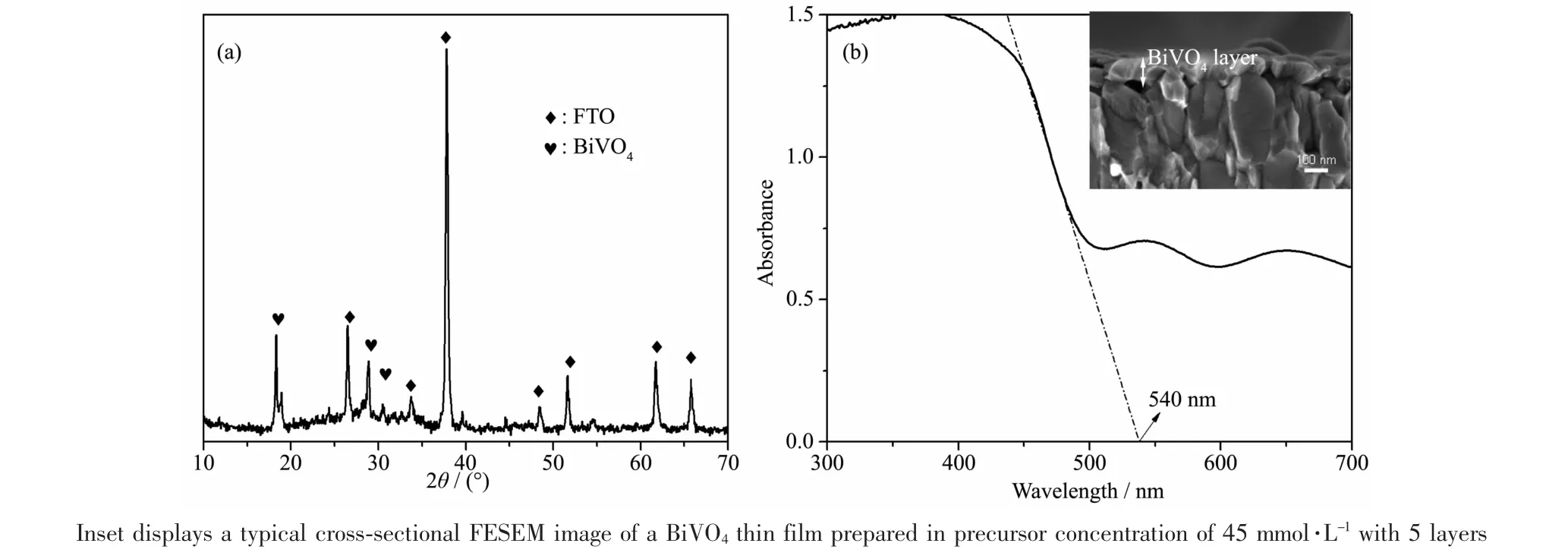
Fig.2 Typical XRD pattern(a)and optical absorption spectra(b)of BiVO4porous thin films which were deposited on FTO substrates(5 cycles)directly
2.1 Effect of electrolyte composition
Fig.3 shows the influence of electrolyte component on the actual PEC performance of the BiVO4films.It is found that the photocurrent density is independent on the electrolyte concentration while strongly dependent on the electrolyte composition.In details,no obvious changes are observed in the LSV or J-t plots with only increasing the concentration of Na2SO4from 0.1 to 1.0 mol·L-1,while the photocurrent is enhanced significantly after adding 0.1 molinto the 0.1 molsolution.It suggests that the performance of a photoanode is very sensitive to the hole scavenger Na2SO3in the electrolyte.Namely,the anion SO32-could react with the photoexcited holes more easily than OH-in the water,leading to a large enhancementofthe photocurrent density.
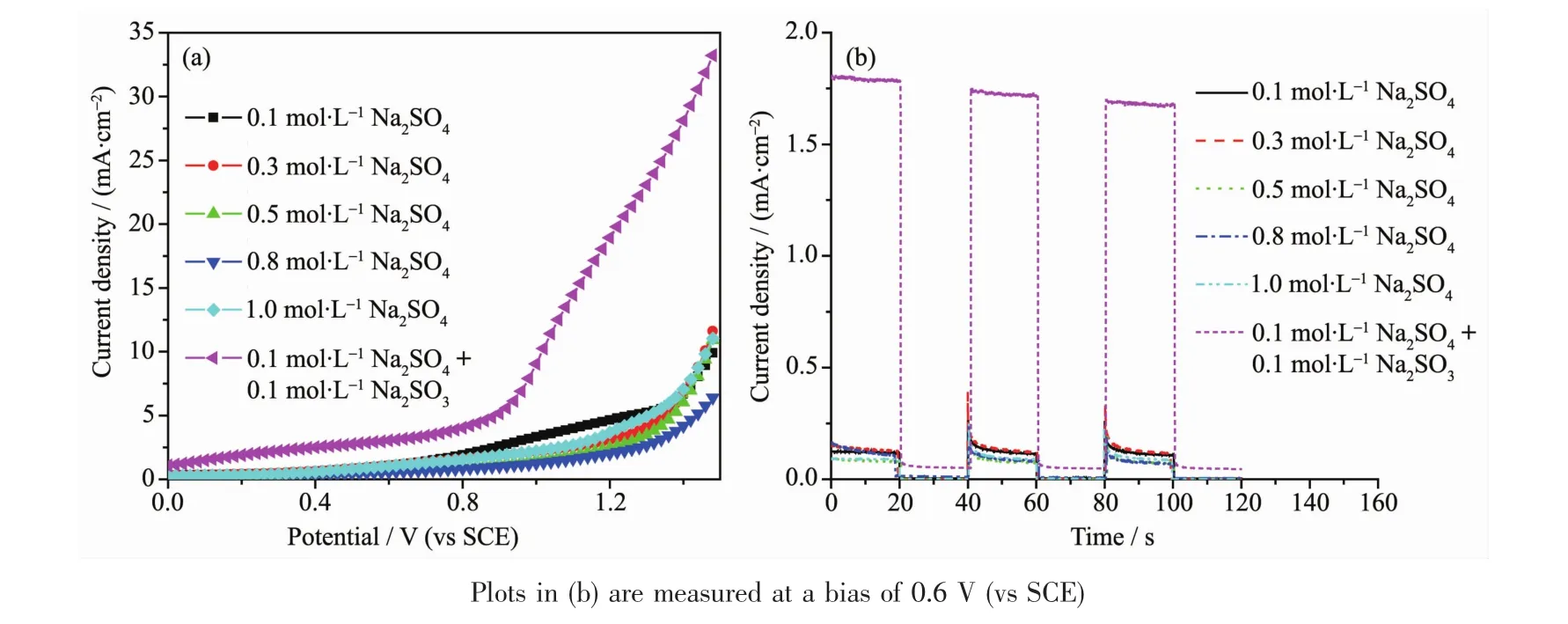
Fig.3 LSV plots(a)and J-t plots under a chopped irradiation(b)of BiVO4thin porous films laid in different electrolytes containing of Na2SO3and Na2SO4
2.2 Effect of precursor concentrations
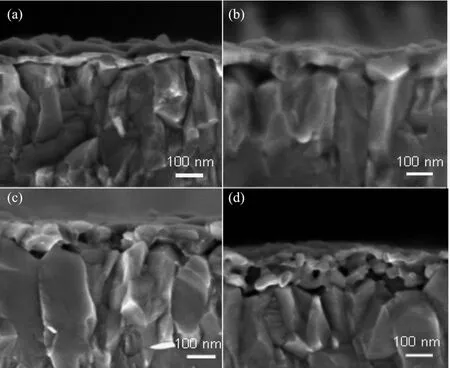
Fig.4 Cross-sectional FESEM images of BiVO4porous thin films fabricated in different precursor concentrations of(a)15,(b)30,(c)45 and(d)60 mmol·L-1with a constant cycle number of 5
Fig.4 displays the cross-sectional SEM images of BiVO4synthesized byusing the precursorswith various concentrations.Apparently,the thicker the precursor solution,the larger thickness is the BiVO4layer.It is reasonable that the films are thickened from ~30 to ~210 nm with increasing the precursor concentration from 15 to 60 mmol·L-1,while they display a porous structure due to the evaporation of organic components.Of these samples,the one deposited at a precursor concentration of 45 mmol·L-1displays a film thickness of~120 nm.
Fig.5 displays the UV-Vis absorption spectra of the BiVO4films with different precursor concentrations.Apparently,the visible-light harvesting of the photoanode gets enhanced a lot with increasing the precursor concentration,which is a result of the improved film thickness.Besides,it is also found that the optical bandgap (Eg)is reduced slightly due to a larger influence of the BiVO4in the entire BiVO4/FTO bilayered films.It is known that BiVO4owns a narrower bandgap(Eg=2.4 eV)than FTO(Eg=3.6~4.0 eV),thus a larger content ratio of BiVO4/FTO would result in a narrower bandgap of the sample.

Fig.5 UV-Vis diffusion absorption spectra of BiVO4 porous thin films fabricated in different concentrations of the precursor solution(from 15 to 60 mmol·L-1)using a constant cycle number of 5
Fig.6 also displays the LSV plots of BiVO4films with differentconcentrations ofprecursor.Itis observed that the highest photocurrent density(1.49 mA·cm-2at 0.6 V(vs SCE))appears in the BiVO4film deposited using a 45 mmol·L-1precursor solution.It is easily understood that an increase of film thickness facilitates enhancing the lightharvesting ofa photoanode.However,the actual photocurrent is also limited by the poor carrier diffusion lengths of BiVO4polycrystalline films,which results in a decrease of the photocurrentas the precursorconcentration increases from 45 to 60 mmol·L-1.
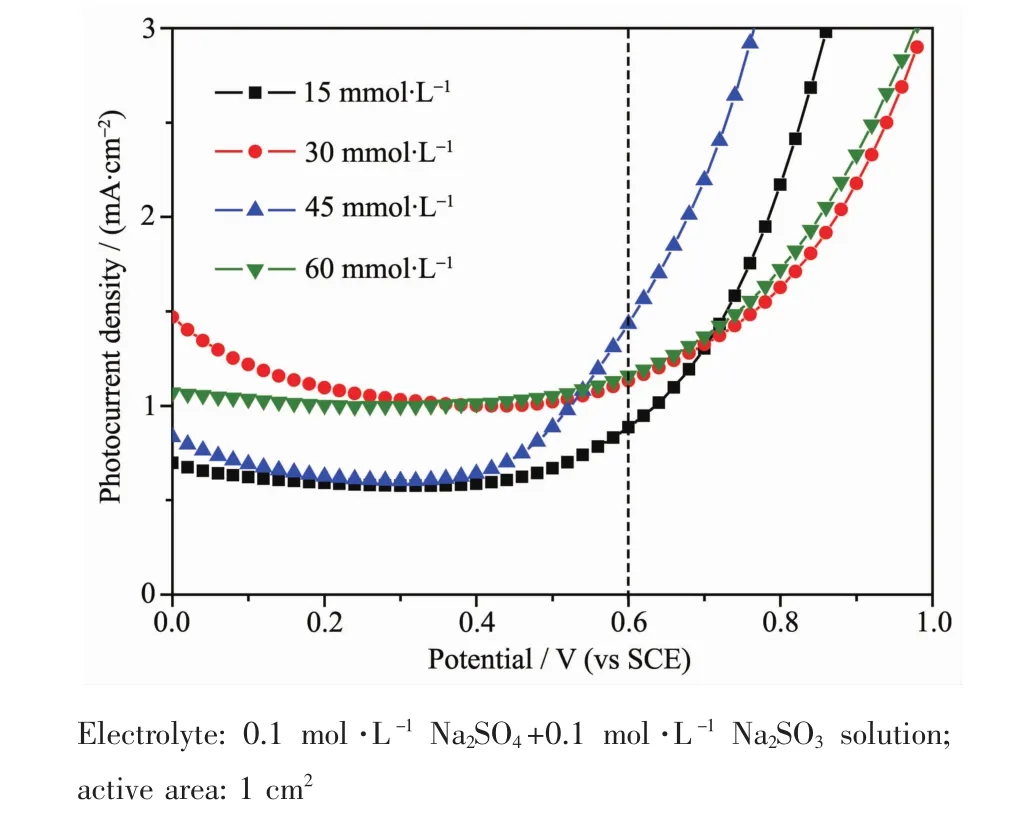
Fig.6 LSV plots under a continuous irradiation of BiVO4porous thin films which were prepared using different concentrations of precursor solution
2.3 Effect of deposition cycles
Fig.7 indicates the cross-sectional SEM images of BiVO4films deposited with various layer numbers.As expected,both the thickness and porosity are enhanced significantly afterincreasing the layer number from 2 to 10.Apparently,it can reach the identical effect with an increase of precursor concentration.Accordingly,the effect of deposition cycles(namely,layer numbers)on the PEC activity is also examined in Fig.8.It is clearly observed that the BiVO4sample with 5 deposition cycles displays the highest photocurrent value at 0.6 V(vs SCE)of all.In other words,when the layer number exceeds 5,the photocurrent is reduced accordingly due to a limitation of the charge carrier diffusion length.That is to say,the optimal PEC performance is achieved in the BiVO4films with a layer number of 5 or thickness of~120 nm.

Fig.7 Cross-sectional FESEM images of BiVO4porous thin films fabricated using a precursor concentration of 45 mmol·L-1and different layer number of(a)2,(b)5,(c)7 and(d)10
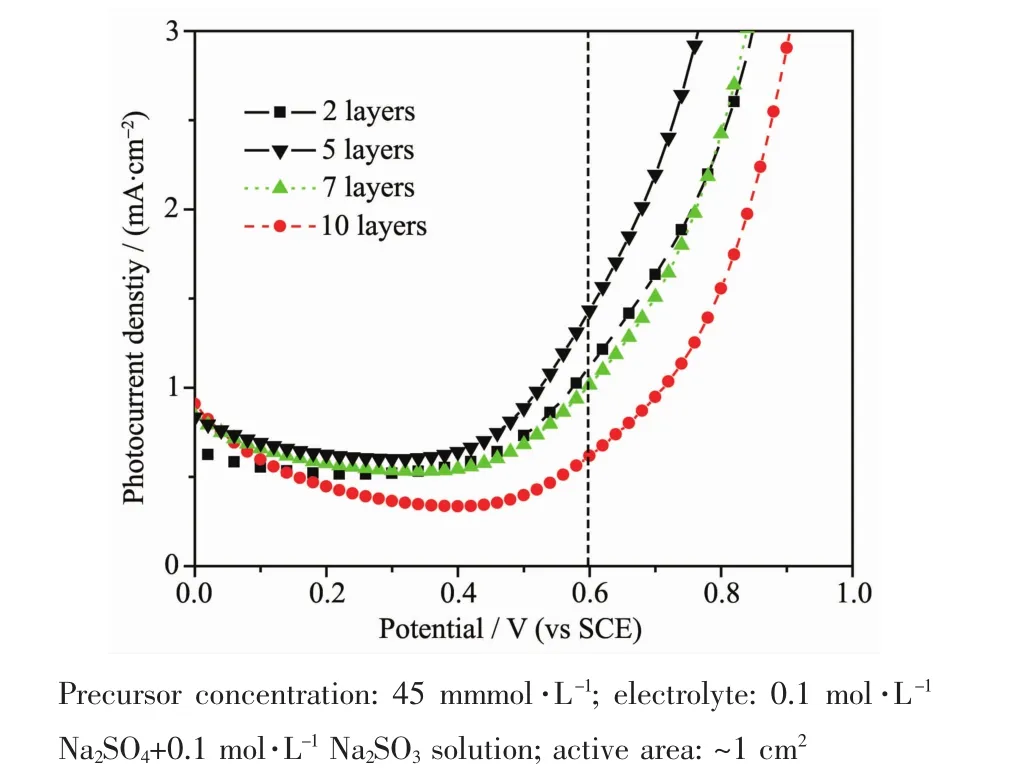
Fig.8 LSV plots under a continuous irradiation of BiVO4 porous thin films prepared using different layer numbers

Fig.9 Amperometric J-t plots(a)and linear relationship between photocurrent density and GSH concentration(b)of a BiVO4PEC bio-sensor with an addition of GSH to reach the concentrations of 0~1 000 μmmol·L-1in the electrolyte;(c)Selectivity experiment by testing in the solutions containing different organic interferents including PBS,L-Cystenine,L-Tyrosine,Glucose,Cystine,L-Glutamic Acid,AA,where the concentrations of these interferents are 20 μmol·L-1while that of GSH is 100 μmol·L-1;(d)Possible mechanism for the PEC detection of GSH
Further,we also assembled a PEC sensor by using a porous BiVO4film electrode,and the biosensing performance of this device was measured at zero bias(0 V vs SCE),as indicated in Fig.9.Herein,the BiVO4film was fabricated under the optimal condition(45 mmol·L-1and 5 layers).At first,a series of sharp peaks in the J-t plots(similar with the phenomenon appeared in references[23-24]),suggesting that there is an instability in the photocurrent(Fig.9a).Such a behavior may be due to the poor charge separation on BiVO4surfaces or interfaces under zero bias.Besides,with increasing the GSH concentration(from 0 to 1 000 μmol·L-1),the photo-response is enhanced significantly,which displays an acceptable sensitivity for detecting the GSH (Fig.9b).And also,this BiVO4biosensor also exhibits much higher photoresponse towards detection ofGSH than other additives(Fig.9c),which was attributed to the higher redox capability of GSH.Namely,it was easy to realize a conversion of GSH to the oxidized glutathione(GSSG)through the following reaction[25]:2GSH+2h++2OH-→GSSG+2H2O.The possible mechanism for the PEC detection of GSH is shown in Fig.9d.Apparently,under a visible light irradiation,a number of electron-hole pairs are produced inside a porous BiVO4film.The existence of the GSH species in an electrolyte acceleratesthe consumption ofholes,leading to a faster migration of the electron towards the opposite direction(i.e.,the photocurrent).In other words,the GSH plays a role of the hole sacrificial agent,leadingtoan acceleration ofthe carrier separation and an enhancement of the photocurrent output.
2.4 Effect of Co-Pi modification
In this section,the effect a Co-Pi modification was investigated on the PEC activity of a BiVO4electrode.Table 1 displays the actual composition of the Co-Pi/BiVO4film sample.The elements of Co and P are clearly identified with considerable contents,which demonstrates a success in the Co-Pi modification.Note that all the elements(Bi,V,Co,etc.)could be viewed as the oxides exist in the sample,where the elements Na,Si and Ca are from the glass substrate.

Table 1 Composition analysis of the Co-Pi modified BiVO4thin film via an electron microprobe
Fig.10 displays a comparison of the LSV plots of BiVO4films before and after Co-Pi modification.Apparently,the photocurrent of a BiVO4electrode is enhanced a lot after coating with a co-catalyst Co-Pi,reaching to a value of 4.3 mA·cm-2at a bias of 0.6 V(vs SCE).Such a value is comparable to several previous reports.Further,the mechanism for the performance enhancement is also revealed through an EIS analysis,including the Nyquist and Mott-Schotty plots displayed in Fig.11a and 11b,respectively.Typically,during an equivalent circuit model displayed in the inset of Fig.11a,RSrepresents the series resistance from the solid electrode,electrolyte and wires,while RCTrepresents the charge transfer resistance occurred atthe electrode/electrolyte interface.As indicated in Table 2,the parameters Ndand Vfbrepresent the donor concentration and flat-band potential of a BiVO4film electrode, respectively. Both of them can be determined from a linear fitting of the Mott-Schotty plots in Fig.11b.Herein,Ndis inversely proportional to the slope of the fitted curve,while Vfbcorresponds to the intercept of the fitted plot on the X-axis.Notably,after a Co-Pi modification,RCTgets smaller while Vfbbecomes more positive,implying that the charge transfer resistance is reduced a lot.That is to say,the PEC performance enhancement is attributed to a more efficient interfacial charge transfer process.

Fig.10 LSV plots under a continuous irradiation of BiVO4porous thin films with and without the Co-Pi modification

Fig.11 Comparison on the Nyquist(a)and Mott-Schotty plots(b)of BiVO4porous thin films with and without the Co-Pi modification

Table 2 Calculated electronic parameters from Nyquist plots under illumination and Mott-Schotty plots measured in dark of BiVO4electrodes by terms of the corresponding model or formula[24]
3 Conclusions
BiVO4porous thin films have been prepared through a facile spin-coating route,followed by an airannealing treatment process for PEC applications.The effects of electrolyte composition and preparation parameters(layer thickness)were investigated,too.The PEC activity of BiVO4could be enhanced efficiently by adding the hole scavenger SO32-into the electrolyte.Otherwise,it was also found that the BiVO4film exhibit the optimal PEC performance (~4.3 mA·cm-2)after using a 45 mmol·L-1precursor,depositing for 5 layers(with a thickness of~120 nm)and modifying with Co-Pi thin layer,and using a 0.1 mol·L-1Na2SO4+0.1 mol·L-1Na2SO3solution as the electrolyte.Finally,a PEC bio-sensor based on BiVO4has been fabricated for detecting the GSH,leading to an acceptable sensitivity.
[1]Chen X B,Li C,Grtzel M,et al.Chem.Soc.Rev.,2012,41:7909-7937
[2]Ma Y,Wang X L,Jia Y S,et al.Chem.Soc.Rev.,2014,114(19):9987-10043
[3]Zhang X F,Zhang B Y,Cao K,et al.J.Mater.Chem.A,2015,3:21630-21636
[4]Fujishima H,Honda K.Nature,1972,238:37-38
[5]YUAN Su-Jun(袁素珺),ZHANG Qing-Hong(张青红),LEI Fang(雷芳),et al.Chinese J.Inorg.Chem.(无机化学学报),2015,31(6):1099-1104
[6]XU Zhen(许贞),LI Juan(李娟),LI Xin-Jun(李新军).Chinese J.Inorg.Chem.(无机化学学报),2013,29(3):429-436
[7]Mayer M T,Lin Y,Yuan G,et al.Acc.Chem.Res.,2013,46(7):1558-1566
[8]Hong S J,Lee S,Jang J S,et al.Energy Environ.Sci.,2011,4:1781-1787
[9]Li K,Zhang H B,Tang Y P,et al.Appl.Catal.B,2015,164:82-91
[10]Sui M R,Han C P,Wang Y,et al.J.Mater.Sci.-Mater.Electron.,2016,27:4290-4296
[11]Zhang S,Gu X Q,Zhao Y L,et al.Mater.Sci.Eng.B,2015,201:57-65
[12]ZHANG Yan(张妍),YU Jian-Qiang(于建强),GAO Xing-Long(高行龙),et al.Chinese J.Inorg.Chem.(无机化学学报),2011,27(1):141-144
[13]Li J T,Wu N Q.Catal.Sci.Technol.,2015,5:1360-1384
[14]Kim J H,Jang J W,Jo Y H,et al.Nat.Commun.,2016,7:13380(9 Pages)
[15]Sayama K,Nomura A,Zou Z,et al.Chem.Commun.,2003(23):2908-2909
[16]Ma M,Kim J K,Zhang K,et al.Chem.Mater.,2014,26:5592-5597
[17]Zhang L W,Reisner E,Baumberg J J.Energy Environ.Sci.,2014,7:1402-1408
[18]Park Y,McDonald K J,Choi K S.Chem.Soc.Rev.,2013,42:2321-2337
[19]Zhong D K,Choi S,Gamelin D R.J.Am.Chem.Soc.,2011,133:18370-18377
[20]Thalluri S M,Hernández S,Bensaid S,et al.Appl.Catal.,B,2016,180:630-636
[21]Jo W J,Jang J W,Kong K,et al.Angew.Chem.Int.Ed.,2012,51(13):3147-3151
[22]Rao P M,Cai L L,Liu C,et al.Nano Lett.,2014,14(2):1099-1105
[23]Ng Y H,Iwase A,Kudo A,et al.J.Phys.Chem.Lett.,2010,1(17):2607-2612
[24]Zhang S,Gu X Q,Zhao Y L,et al.J.Electron.Mater.,2016,45(1):648-653
[25]Zhao K,Yan X Q,Gu Y S,et al.Small,2016,12(2):245-251

